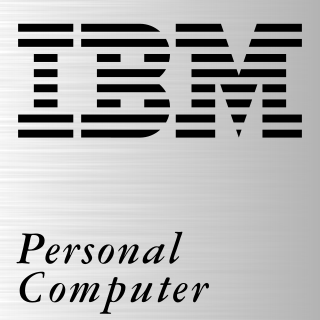
The IBM Personal Computer is the first microcomputer released in the IBM PC model line and the basis for the IBM PC compatible de facto standard. Released on August 12, 1981, it was created by a team of engineers and designers at International Business Machines (IBM), directed by William C. Lowe and Philip Don Estridge in Boca Raton, Florida.
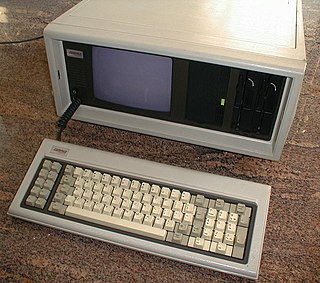
IBM PC–compatible computers are technically similar to the original IBM PC, XT, and AT, all from computer giant IBM, that are able to use the same software and expansion cards. Such computers were referred to as PC clones, IBM clones or IBM PC clones. The term "IBM PC compatible" is now a historical description only, since IBM no longer sells personal computers after it sold its personal computer division in 2005 to Chinese technology company Lenovo. The designation "PC", as used in much of personal computer history, has not meant "personal computer" generally, but rather an x86 computer capable of running the same software that a contemporary IBM PC could. The term was initially in contrast to the variety of home computer systems available in the early 1980s, such as the Apple II, TRS-80, and Commodore 64. Later, the term was primarily used in contrast to Apple's Macintosh computers.
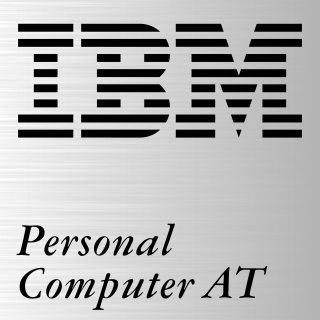
The IBM Personal Computer AT was released in 1984 as the fourth model in the IBM Personal Computer line, following the IBM PC/XT and its IBM Portable PC variant. It was designed around the Intel 80286 microprocessor.
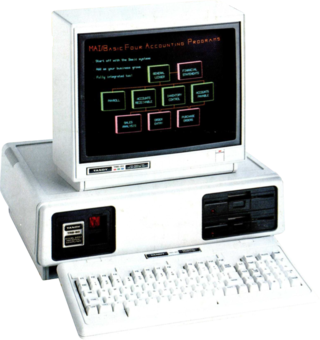
The Tandy 2000 is a personal computer introduced by Radio Shack in September 1983 based on the 8 MHz Intel 80186 microprocessor running MS-DOS. By comparison, the IBM PC XT used the older 4.77 MHz Intel 8088 processor, and the IBM PC/AT would later use the newer 6 MHz Intel 80286. Due to the 16-bit data bus and more efficient instruction decoding of the 80186, the Tandy 2000 ran significantly faster than other PC compatibles, and slightly faster than the PC AT. The Tandy 2000 was the company's first computer built around an Intel x86 series microprocessor; previous models used the Zilog Z80 and Motorola 6809 CPUs.

Professional Graphics Controller is a graphics card manufactured by IBM for PCs. It consists of three interconnected PCBs, and contains its own processor and memory. The PGC was, at the time of its release, the most advanced graphics card for the IBM XT and aimed for tasks such as CAD.

The Gavilan SC is an early laptop computer first released by the Gavilan Computer Corporation in April 1984. The computer ran on an Intel 8088 microprocessor running at 5 MHz and sported a touchpad for a pointing device, one of the first computers to do so. The laptop was developed by Manuel "Manny" Fernandez, founder of the Gavilan Computer Corporation, and unveiled in May 1983.

Following the introduction of the IBM Personal Computer, or IBM PC, many other personal computer architectures became extinct within just a few years. It led to a wave of IBM PC compatible systems being released.
The MBC-550 series, also known as the MBC-550/555, is a series of personal computers sold by Sanyo. It was unveiled at the COMDEX/Spring '83 in April 1983 and first released to market in March 1984. All models in the MBC-550 series featured pizza-box-style cases and Intel 8088 microprocessors and run versions of MS-DOS. On its release in 1984, the MBC-550 was the least expensive IBM PC compatible released to date, at a price of $US$995. The MBC-550 series followed Sanyo's MBC-1000 line of CP/M computers.

The IBM Personal Computer XT is the second computer in the IBM Personal Computer line, released on March 8, 1983. Except for the addition of a built-in hard drive and extra expansion slots, it is very similar to the original IBM PC model 5150 from 1981.
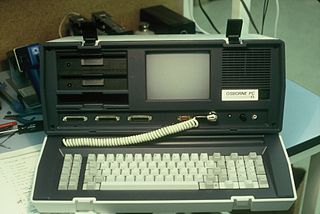
The Osborne PC is an unreleased IBM PC–compatible personal computer developed between 1983 and 1984 by Osborne Computer Corporation. Only prototypes of the computer were ever produced.

Blue Chip Electronics, Inc., later Blue Chip International, was an American computer company founded by John Rossi in 1982. Founded to develop peripherals for Commodore home computers, the company in 1986 began selling low-cost IBM PC compatibles.

Reply Corporation, often shortened to Reply Corp., was an American computer company based in San Jose, California. Founded in 1988 by Steve Petracca, the company licensed the Micro Channel architecture from IBM for their own computers released in 1989, competing against IBM's PS/2 line. The company later divested from offering complete systems in favor of marketing motherboard upgrades for older PS/2s. Reply enjoyed a close relationship with IBM, owing to many of its founding employees, including Petracca, having worked for IBM. The company was acquired by Radius in 1997.
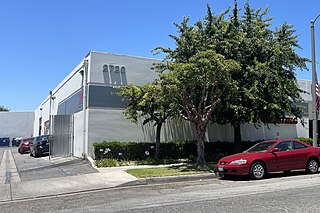
American Computer & Peripheral, Inc. (AC&P), also written as American Computer and Peripheral, was an American computer company based in Santa Ana, California. The company was founded in 1985 by Alan Lau and released several expansion boards for the IBM PC as well as a few PC clones before going bankrupt in December 1989. Obscure in its own time, the company's 386 Translator was the first plug-in board for Intel's newly released 80386 processor and the first mass-market computing device to offer consumers a means of using the 386 in July 1986.

Advanced Logic Research, Inc. (ALR), was an American computer company founded in 1984 in Irvine, California by Gene Lu. The company marketed IBM PC compatibles across that standard's evolution until 1997 when it was acquired by Gateway 2000.

The Dimension 68000 is a microcomputer introduced by the Micro Craft Corporation in 1983 that sought to emulate the Apple II, the IBM PC, and various CP/M-centric computers through a family of coprocessor expansion cards and emulation software. The Dimension 68000 can also run as a standalone computer based on the Motorola 68000 from which it gets its namesake. The computer is mostly the brainchild of Mike Carpenter, a former executive of a scientific instrument manufacturer who incorporated Micro Craft in Dallas, Texas, to develop the Dimension 68000. It had a market lifespan of three years and received mixed, mostly positive, reception from the technology press. Criticism was leveled at the $6,250 price tag for the computer with the full deck of coprocessor cards, as well as the extent of the emulation power of those cards.

Aox Inc. was a privately run American technology corporation founded by Michael and Linda Aronson in 1978. Over the course of its 22-year lifespan, the company chiefly developed software and hardware for IBM's PC and compatibles, for the Personal System/2, and for the Macintosh. In its twilight years, the company designed multimedia and teleconferencing devices and chip designs. Aox was founded after Michael Aronson graduated from Harvard University with a doctorate in physics; he stayed with the company until 2000, when he incorporated EndPoints Inc. and switched to full-time fabless semiconductor design.
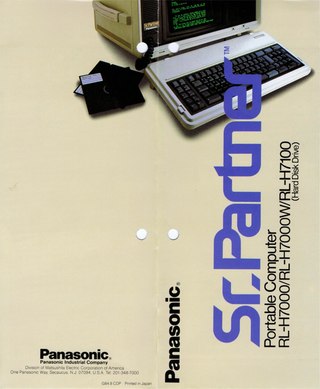
The Senior Partner is an IBM PC-compatible portable computer that was introduced by the Panasonic Corporation in 1984. Weighing roughly 31 pounds (14 kg) in its base configuration, the computer came equipped with a cathode-ray tube display and a built-in thermal printer.
The MAD-1 is an IBM PC–compatible desktop computer released by Mad Computers, Inc., of Santa Clara, California, in 1984. The computer was noted among the technology press for its unique, modular design and its 80186 microprocessor, the latter seldom used in PC compatibles. It received positive reviews but sold poorly and was pulled from market a year later.
CompuSource Compatible Systems Inc. was a short-lived privately held American computer company active in the 1980s and based in Minneapolis. It sold a variety of clones of the Apple II, including one portable that was also an IBM PC clone and a CP/M machine.
The Dot was a portable computer released by Computer Devices, Inc. in April 1983.
















